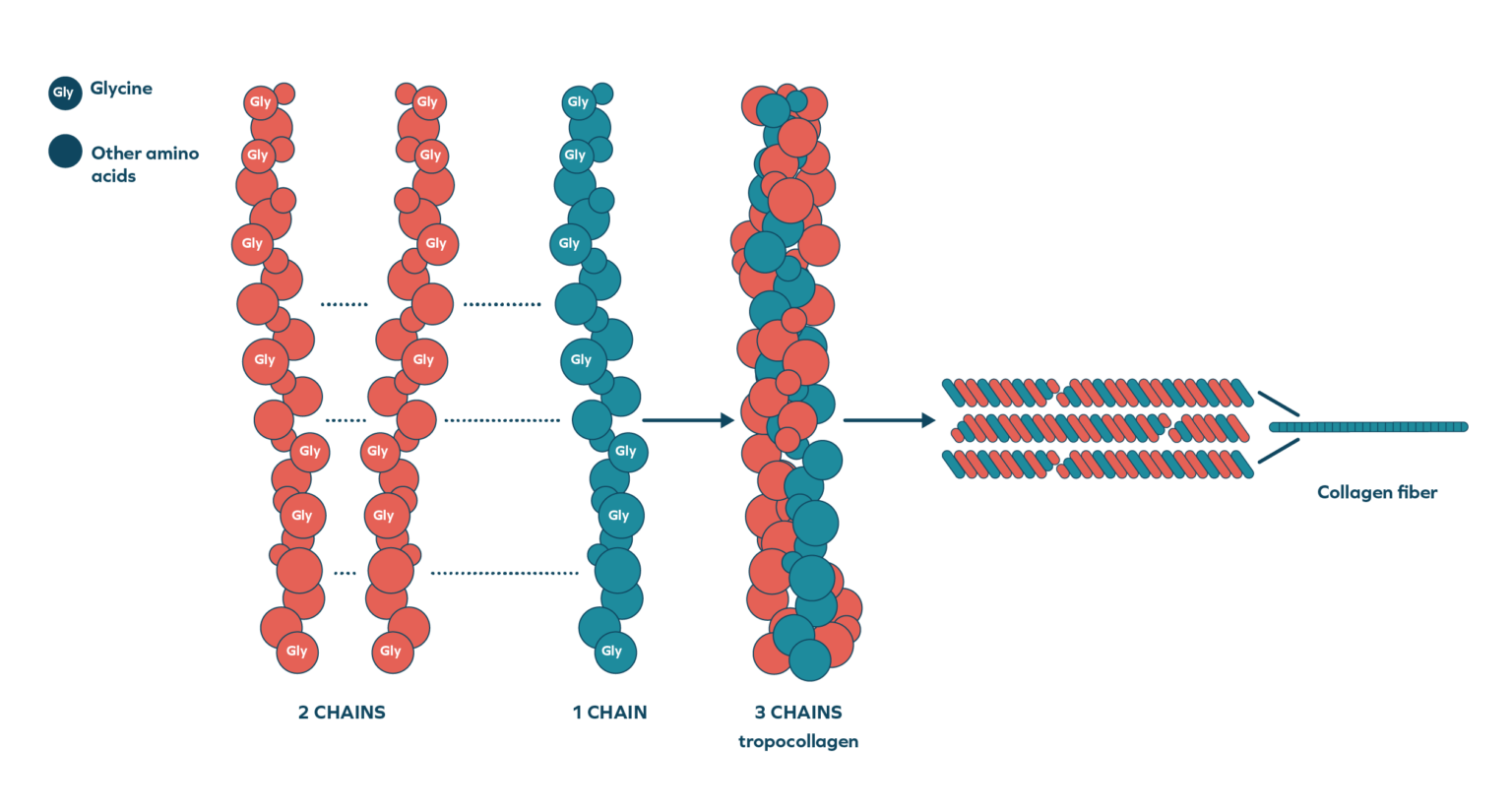All about marine collagen peptides
To understand the role of collagen peptides, it is essential to look at collagen as a whole and discover its composition, its different types and their associated functionalities.
Collagen, a protein essential to the human body
Native collagen is a structural protein of the glycoprotein family. Structural because it is found in the extracellular matrix of the human and animal bodies. It participates in cellular organization and thus in the overall structure of our body. Beyond its structural role, this protein participates in the proper functioning of the body by ensuring the integrity, firmness, and elasticity of our connective tissues.
Collagen constitutes one-third of the protein present in our body¹. It is abundant in the skin, but also in our tendons, ligaments, and blood vessel walls.
Different types of collagen
To be precise, we must talk about collagens plural, since there are 28 different types. Each type of collagen is determined according to its structure and functionality.
The structure common to all types of native collagens is a triple helix of intertwined polypeptides chains of very high molecular weight (300,000 Da). The three chains are built by our own cells by linking numerous amino acids together, such as glycine. The association of several helices then forms solid fibers that reinforce the structure of our body.
The difference between the types of collagens lies mainly in the sequence and binding of the different peptides. For example, type I collagen is made up of two identical polypeptides chains and one different chain, whereas type II collagen is made up of three identical chains.
The winding of these three chains constitutes the fundamental unit of native collagen, which is called « tropocollagen ».
Synthesis and structure of collagen

Type I collagen is the most abundant in our body: it is found in our bones, our skin, our tendons, and even our internal organs.
What is the impact of aging on collagen?
As we get older, the amount of collagen in our body decreases. This leads to a loss of overall elasticity and a loosening of the skin and joints. This decline in collagen is not only at the root of the appearance of wrinkles, but also of joint discomfort and has a generally negative impact for the maintenance of a healthy body.
As we age, the best way to maintain a sufficient level of collagen is to provide our bodies with extra sources of it, either through our diet or by taking supplements.

Collagen peptides, highly bioavailable
Collagen peptides are the elements which make up the helical chains of the collagen protein.
The 2 main advantages of collagen peptides are:
Their solubility, whereas native collagen is not soluble,
Their high level of absorption by the body, thanks to their lower molecular weight.
To obtain them, polypeptides chains are cut into pieces thanks to a process known as hydrolysis. As Naticol® collagen peptides are derived from fish skins, the process is carried out in two steps:
- 1st step: extraction of the collagen from fish skin and purification,
- 2nd step: enzymatic hydrolysis of the collagen extracted and purification of the peptides obtained.
Enzymatic hydrolysis

Weishardt has developed its own unique and controlled enzymatic hydrolysis process that leads to the production of Naticol® collagen peptides. Indeed, we specifically select the enzymes together with the hydrolysis temperature and duration.
We carry out a gentle enzymatic process until the peptides have reached the required molecular weight. We then spray dry the liquid hydrolysate. The product can also undergo agglomeration to obtain collagen peptides which are easily dissolved in water.
The hydrolysis parameters will determine the different physico-chemical and organoleptic characteristics of the obtained peptides.
Their absorption by the body is then easy and fast². Absorption depends on the molecular weight of the peptides but also on their affinity with the intestinal membrane.
Naticol® contains 7 of the 9 essential amino acids, which gives it excellent nutritional qualities.
Beyond their physiological advantages, Naticol® collagen peptides are pure and of 100% natural origin. They are derived from marine collagen extracted from fish skins. They do not undergo any ionization or irradiation treatment.
Would you like to discover our range of Naticol® collagen peptides?
¹ Shoulders, M. (2009), Annu Rev Biochem., 78:929-58.
² Iwai, K. (2005), J Agric Food Chem., 53(16):6531-6.
Disclaimer :
Naticol®, an ingredient marketed by Weishardt, is intended to be incorporated into food products or food supplements by specialized companies.
And as such, the information mentioned on this page is specifically intended for them.
In accordance with the requirements of the European Directive 2006/114/EC, Weishardt guarantees the veracity of the information relating to the beneficial effects of Naticol® on health when used under the conditions in which it has been tested.
However, this in no way exempts those placing on the market foodstuffs and food supplements incorporating Naticol® from verifying the veracity of these statements when it is used in their product(s).
In addition, the European Regulation 1924/2006/EC frames the use of nutrition and health claims on foodstuffs intended for the final consumer. The claims related to the health benefits of Naticol®, as mentioned on this page, are therefore not covered by the requirements of this regulation. Therefore, Weishardt cannot be held responsible when this information is reused by those placing on the market in their communication materials for their finished products.
This information has not been evaluated by the Food and Drug Administration.